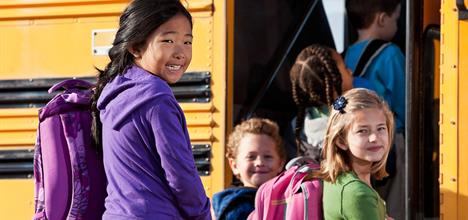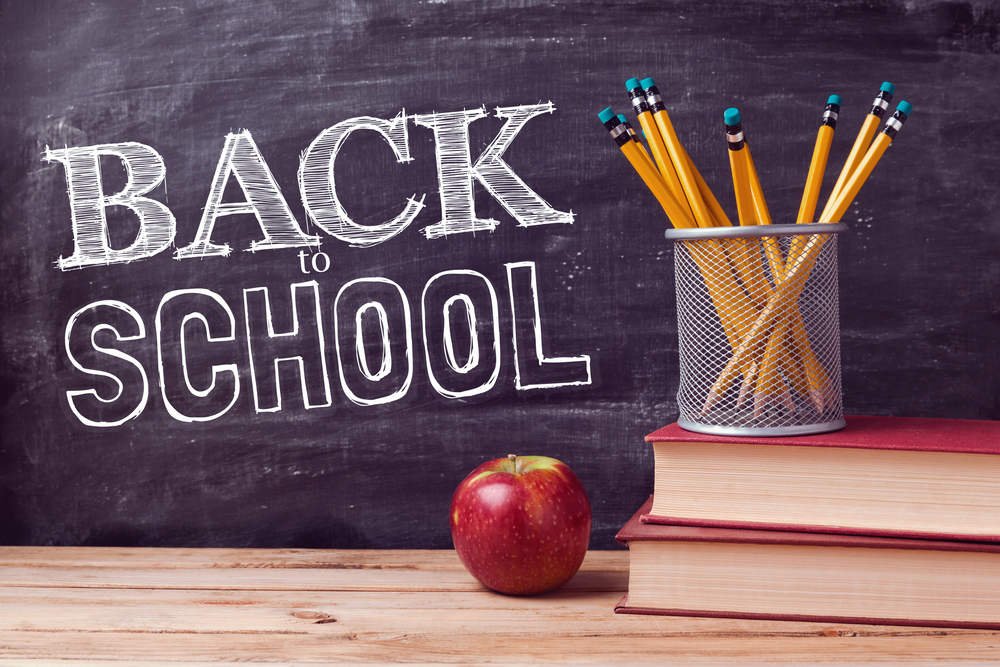Before it’s time to head back to school, use these tips to help ensure your child has a safe, healthy and happy year.
Make the first day of school easier for kids
- Take your child to visit the new school or classroom before the first day of school. Attend any available orientations and take an opportunity to tour the school. You can also bring your child to school a few days prior to class to play on
- Remind your child that teachers know that students may be nervous about the first day of school; they will make an extra effort to make sure everyone feels as comfortable as possible. If your child seems nervous, ask them what they are worried about and help them problem-solve ways to master the new situation.
- Point out the positive aspects of school starting to help your kids look forward to the first day of class. Talk about how they will see old friends and meet new ones, for example.
- Find another child in the neighborhood you child can walk to school or ride with on the bus. If you feel it is needed, drive your child (or walk with them) to school and pick them up on the first day. Get there early on the first day to cut down on unnecessary stress the playground to help them feel comfortable. Many children get nervous about new situations, including changing to a new school, classroom or teacher. It can be helpful to rehearse heading into the new situation.
Develop a healthy sleep routine
- Help your child adjust to earlier bedtimes a week or two before the new school year starts, just to help them ease into new routines. Set a consistent bedtime for your child and stick with it every night. Getting enough sleep is critical for kids to stay health and be successful in school. Not getting enough sleep is linked with lower academic achievement, as well as higher rates of absenteeism and tardiness.
- Create a bedtime routine that is consistent to help your child settle down and fall asleep. For example, a calming pre-bedtime routine may involve a bath/shower, reading with them, tucking them in and saying goodnight.
- Have your child turn off electronic devices well before bedtime. Try to have the home as quiet and calm as possible when younger children are trying to fall asleep.
Plan for safe travel to & from school

Review the basic rules with your student and practice any new routes or modes of transportation:
Taking the school bus
- Remind your child to wait for the bus to stop before approaching it from the curb. Kids should always board and exit the bus at locations that provide safe access to the bus or to the school building. Make sure your child walks where they can see the bus driver (which means the driver will be able to see them, too).
- Remind your student to look both ways to see that no other traffic is coming before crossing the street, just in case somebody does not stop as required. Encourage your child to actually practice how to cross the street several times before the first day of school.
- If the school bus has lap/shoulder seat belts, make sure your child uses one at all times when in the bus. (If your child’s school bus does not have lap/shoulder belts, encourage the school system to buy or lease buses with lap/shoulder belts).
- Check on the school’s policy regarding food on the bus. Eating on the bus can present a problem for students with allergies and also lead to infestations of insects and vermin on the vehicles.
- If your child has a chronic condition that could result in an emergency on the bus, make sure you work with the school nurse or other school health personnel to have a bus emergency plan. If possible, do this before the first day of class.
Provide health eating options during the school day
- Children who eat a nutritious breakfast function better. They do better in school, and have better concentration and more energy. Some schools provide breakfast for children; if yours does not, make sure they eat a breakfast that contains some protein. If your child does not have time to eat, send them to school with a grab and go snack like a granola bar.
- Many children qualify for free or reduced price food at school, including breakfast. The forms for these services can be completed at the school office. Hunger will affect a child’s performance in class.
- Many school districts have plans which allow you to pay for meals through an online account. Your child can get a card to “swipe” at the register. This is a convenient way to handle school meal accounts.
- Look into what is offered inside and outside of the cafeteria, including vending machines, a la carte, school stores, snack carts and fundraisers held during the school day. They should stock healthy choices such as fresh fruit, low-fat dairy products and water. Learn about your child’s school wellness policy and get involved in school groups to put it into effect. Also, consider nutrition if your child will be bringing food to eat during school.
- Choose healthier beverage options such as water to send in your child’s lunch. Each 12-ounce soft drink contains approximately 10 teaspoons of sugar and 150 calories. Drinking just one can of soda a day increases a child’s risk of obesity by 60%.
Prevent bullying at school
Bullying or cyberbullying is when one child picks on another child repeatedly. Bullying can be physical, verbal, or social. It can happen at school, on the playground, on the school bus, in the neighborhood or through mobile devices like cell phones.
- Children who eat a nutritious breakfast function better. They do better in school, and have better concentration and more energy. Some schools provide breakfast for children; if yours does not, make sure they eat a breakfast that contains some protein. If your child does not have time to eat, send them to school with a grab and go snack like a granola bar.
- Many children qualify for free or reduced price food at school, including breakfast. The forms for these services can be completed at the school office. Hunger will affect a child’s performance in class.
- Many school districts have plans which allow you to pay for meals through an online account. Your child can get a card to “swipe” at the register. This is a convenient way to handle school meal accounts.
- Look into what is offered inside and outside of the cafeteria, including vending machines, a la carte, school stores, snack carts and fundraisers held during the school day. They should stock healthy choices such as fresh fruit, low-fat dairy products and water. Learn about your child’s school wellness policy and get involved in school groups to put it into effect. Also, consider nutrition if your child will be bringing food to eat during school.
- Choose healthier beverage options such as water to send in your child’s lunch. Each 12-ounce soft drink contains approximately 10 teaspoons of sugar and 150 calories. Drinking just one can of soda a day increases a child’s risk of obesity by 60%.
Read the complete article here:
https://www.healthychildren.org/English/ages-stages/gradeschool/school/Pages/back-to-school-tips.aspx






